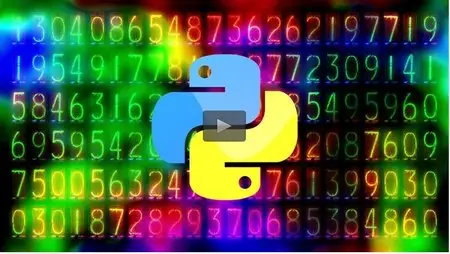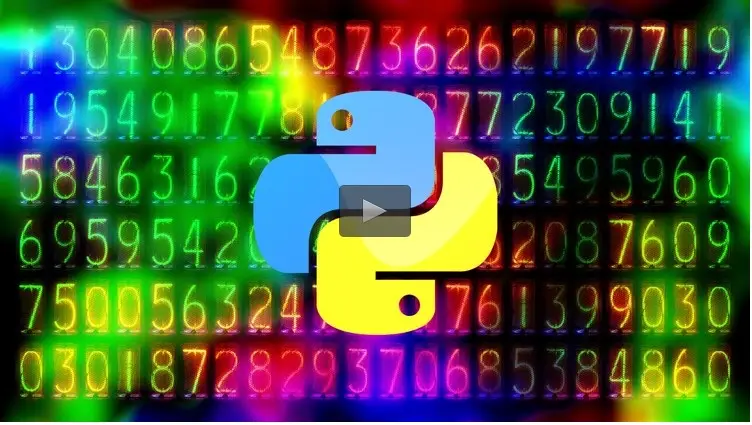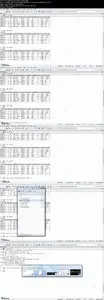Udemy – Python Step by Step: Build a Data Analysis Program (2015)
WEBRip | MP4/AVC, ~634 kb/s | 1280 x 720 | English: AAC, 59.2 kb/s (2 ch), 44.1 KHz | 961 MB
Genre: Development / Programming Languages | Language: English | +Project Files
WEBRip | MP4/AVC, ~634 kb/s | 1280 x 720 | English: AAC, 59.2 kb/s (2 ch), 44.1 KHz | 961 MB
Genre: Development / Programming Languages | Language: English | +Project Files
This is a new Udemy course published on August 4, 2015.Are you struggling to create a real-world Python program?Are you interested in using Python for working with any kind of data?You don't know where to start?Do you need to learn the basics and then jump into a real world program, all in one course? If any of the above identifies with you, then this is the Python course you have been looking for. In this complete course, you will learn how to program with Python starting from the basics and slowly shifting into practical concepts such as handling multiple files and data containing millions of rows and extracting and visualizing information from them.
This course avoids teaching you through trivial traditional examples. Instead, as you progress through the course, you will be guided step by step on building a program that uses real world data containing hundreds of files and millions of records. These data will be downloaded, extracted, cleaned, manipulated, analyzed, aggregated and visualized. And all these operations will be done by the Python program which you will learn to build as the course progresses.
What are the requirements?
- A working computer and internet connection
What am I going to get from this course?
- Over 43 lectures and 4 hours of content!
- Learn how to easily install Python and its libraries.
- Learn the fundamental programming blocks of the language such as variables, datatypes, loops, conditionals and functions.
- Batch download files from FTP sites, extract, rename and store them locally.
- Import data into Python for analysis and visualizations from different sources such as CSV and delimited TXT files.
- Keep the data organized in easily managable data frames.
- Merge large datasets taken from various data file sources.
- Create pivot tables out of large datasets.
- Modify and create new data columns out of existing ones.
- Query data from Python pandas dataframes.
- Export modified datasets into different formats such as text, CSV, and Excel files
- Keep the data organized in easily managable data frames.
- Merge large datasets taken from various data file sources.
- Visualize data by generating various graph image files.
- Create KML Google Earth files out of CSV files.
What is the target audience?
- This course is ideal for those who want to leverage the power of the Python programming language for handling data.
- Ideal for those need to learn the Python basics and want to quickly gain the skills to perform data cleaning, analysis and visualizations with Python.
- Ideal for those need to learn the Python basics and want to quickly gain the skills to perform data cleaning, analysis and visualizations by building a real data analysis program.
- NOT for those who plan to use Python on domains such as game and web development.
- NOT for those who don't have a basic understanding of programming fundamentals such as variables, strings, integers, functions and loops.
- This course is ideal for those who want to leverage the power of the Python programming language for handling data analysis.
Curriculum
Section 1: Getting Started
Lecture 1 A few words about Python 04:30
You will learn a few facts about Python, such as what Python is, what it can do, what fields of technology can Python be used for, where Python stands among the other programming languages and how Python has become so popular.
Lecture 2 Easily installing Python and its specialized libraries 08:24
You will learn how to install Python through the Anaconda package which is a complete package that will not only install Python into your computer, but also other libraries needed for data analysis and visualizations such as pandas, matplotlib, numpy, scipy, etc.
Lecture 3 Spyder and iPython 03:35
You will learn how to use the Spyder environment to write scripts of Python code and also learn how to use iPython which is an enhanced interactive shell where you type in and execute Python code. iPython is tailored for data analysis applications
Quiz 1 Getting Started 3 questions
Section 2: Python Basics
Lecture 4 Variables 02:47
You will be able to declare variables in Python and assign different data types to them, such as strings, integers, and floats.
Lecture 5 Strings and numbers 04:25
You will learn about strings and the different number data types used in Python and how to perform operations with them.
Quiz 2 Variables, strings, and numbers. 4 questions
Lecture 6 If, else, and indentation 04:06
You will learn how to write a small conditional program using the if-else clause. You will also learn about the crucial concept of indentation.
Quiz 3 If, else, and indentation 1 question
Lecture 7 Functions 03:09
You will learn what built-in functions are and also how to create your own customized Python functions and how to call them for generating their output.
Lecture 8 Sequences 02:57
You will understand the structure of list and tuple datatypes and learn how to create them.
Lecture 9 Collections 03:28
You will understand the structure of set and dictionary datatypes and learn how to create them.
Lecture 10 Working with sequences and strings 07:27
You will be able to perform various operations with lists, tuples and strings. You will learn how to use indexing, access list, tuple, and string elements and perform slicing operations.
Lecture 11 Iterating 03:37
You will learn how to use the for loop in Python and also how to integrate an if statement inside a for loop block.
Section 3: Working with Files and Folders
Lecture 12 Working with files 05:29
You will learn how to create and open files from within Python and write lines of text inside TXT files.
Lecture 13 Working with folders 03:50
You will learn how create new directories, how get and change the current working directory, and how to get a list of files contained in a directory.
Lecture 14 Handling files easily 01:44
You will learn the with method which is a great shortcut for handling files in Python.
Lecture 15 Manipulating directory paths 06:47
You will learn how to split file names from full file paths and create new directories if a directory path does not exits.
Lecture 16 Iterating through files 06:09
You will enforce your iterating skills by learning how to use the for loop for accessing and manipulating multiple files at once from within Python.
Section 4: Downloading Files from FTP Sites
Lecture 17 Introduction to section "Downloading files from FTP sites" 01:34
Lecture 18 Logging in to an FTP site and browsing through FTP files 07:00
You will learn how to write Python code that establishes a connection to an FTP server and accesses the files of the FTP site.
Lecture 19 Running Python code from the editor 04:32
You will learn how to use the Spyder editor for executing complete scripts of Python code.
Lecture 20 Creating an FTP function 02:29
You will learn how to create a custom FTP function that logs in to an FTP site and generates a list of file names contained in the site.
Lecture 21 Downloading an FTP file 08:32
Lecture 22 Practical No.1: Creating a FTP File Downloader 13:40
Here we start building our data analysis program.
In this particular lecture, we will build an FTP function that will login to the FTP site, and download a given range of files from the site.
Section 5: Working with Archive Files
Lecture 23 Extracting ZIP, TAR, GZ and other archive file formats 03:41
You will learn how to extract various types of archive files using the patool library and the for loop.
Lecture 24 Extracting RAR files 01:57
You will learn how to extract RAR archive files.
Lecture 25 Practical No.2: Creating a batch archive extractor 05:52
Here you will write a function that will fetch the archive files downloaded by the FTP function and it will extract them all in a local directory.
Section 6: Reading and Writing TXT and CSV Data Files
Lecture 26 Introduction to section "Reading and writing TXT and CSV data files" 01:22
Lecture 27 Reading delimited TXT and CSV files 10:06
You will learn how to easily read CSV and delimited TXT files using the pandas library and use their data inside Python.
Lecture 28 Exporting data back to files 04:14
You will learn how to export data from Python to CSV and TXT files.
Lecture 29 Reading fixed width TXT files 01:58
You will learn how to open data from TXT files which columns are delimited by a certain width.
Lecture 30 Exporting data back to HTML and other fIle formats 01:02
You will learn how to quickly export a pandas dataframe into an HTML file.
Section 7: A tour with pandas
Lecture 31 Introducing pandas - the great Python data analysis library 06:16
We already used the pandas library in the previous section. Here you will be given an official tour to the pandas data analysis library.
Lecture 32 Practical No.4: Calculating and adding columns to CSV files 04:57
You will create a function that grabs all the TXT files of a folder, opens each of them in Python as dataframes, adds a column in each dataframe and exports the updated dataframes back to CSV files.
Section 8: Concatenating and Joining Tables of Data with Pandas
Lecture 33 Practical No.5: Concatenating multiple CSV files 06:18
You will write a function that gets all the CSV files and concatenates them vertically using the pandas concatenate function by creating a single CSV containing everything.
Lecture 34 Practical No. 6: Joining data based on a matching column 08:59
You will write a function that will join columns of a pandas dataframe to another dataframe.
Section 9: Pivoting Data
Lecture 35 Practical No. 7: Pivoting large amounts of data 07:41
You will learn how to use the pandas pivot function by creating a pivoted dataframe out of a large CSV file by aggregating the data values.
Section 10: Visualizing Data
Lecture 36 How to perform visualizations in Python 11:31
You will learn how to use the visualization features available in Python and generate graphs using the matplotlib and the seaborn libraries.
Lecture 37 More visualization techniques 12:23
You will expand your knowledge on performing visualizations of different kinds out of pandas dataframes and adding labels and legends to the generated graphs.
Lecture 38 Practical No. 8: Generating an image file graph 03:35
You will learn create a function that will access the pivoted dataframe and it will generate a graph representing the data, and save the graph inside a PNG image file.
Section 11: Mapping Spatial Data
Lecture 39 Creating KML Google Earth files 04:37
You will learn how to create a point KML file using the simplekml library and display the file in Google Earth.
Lecture 40 Practical No, 9: Creating KML Google Earth fIles from CSV 07:46
You will create a function that grabs the data from a pandas dataframe and creates a KML file using the latitude and the longitude information contained in the dataframe.
Section 12: Putting everything together
Lecture 41 Practical No. 9: Polishing the program, I 05:00
You will learn how to execute all the functions of the programs in one single click.
Lecture 42 Practical No. 10: Polishing the program, II 05:30
You will learn how to make your program more user friendly by integrating the user input functionality.
Lecture 43 Practical No. 11: Creating a Python module out of your program 05:00
You will learn how to convert your program into a Python module so you can import it in other scripts.
LabView - Collective Books
Mega E-books Pack (2013)
Malware Centric E-book Collection
Huge Electricity, Magnetism, A..., Healing - EBooks Collection
Premium IT eBooks Collection
Huge Encyclopedias - EBooks Collection
Osprey Publishing - Military History Books Collection
Gale Encyclopedias - Full Pack
IT Books Collection (Basic - Intermediate - Advance)
Medicinal and Aromatic Plants - 50 Volume Set
Doctor Who ebooks Collection
Learning HTML Ultimate Collection
Comprehensive Robotics Books Collection
Great Royal Web Design Pack
Civil Engineering Geotechnical books
Luftwaffe Colours Collection
Many Thanks to Original uploader.
For More Rare Movies Check out my blog!
Download Links:
No Mirrors Please





